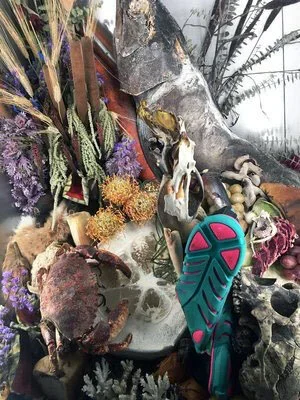PORTRAITS
What Happens at the End of Art and Man?
by Jill Blackford
There was something both intimate and inappropriately voyeuristic about Adrián Villar Rojas’ Theater of Disappearance, like looking into your mother-in-law’s trash bin and finding a dark-web sex doll. The uncommon adage ‘You are what you throw away’ comes to mind: so we’re wasteful, carnivorous, self-important, strange, and sometimes beautiful, Oh, and extinct. But for now, at least, we still have killer ramen.
//
Even for those of us who didn't register that the six-foot frozen bicycle is a dig at Marcel Duchamp (whom the LA Times bodly calls a “Dada imp”), Adrián Villar Rojas’ “Theater of Disappearance” is still derisive in all the right ways.
I saw the Argentinian artist's much-anticipated show—which takes up most of the Geffen Contemporary's warehouse space in Little Tokyo—as part of Quiet Mornings: Art x Mindfulness, Flavorpill’s new L.A. trial of the now-monthly New York City staple. Meditating warm-up aside, the museum experience has been transformed from whitewall brightness into a cavernous womb.
Large stone boulders and tall monuments of layered amber, candy-colored concrete, and if you look closely fossilized fish heads, are the backdrop for diorama-style freezer cases displaying a cornucopia of symbols of (future-lost) humanity: feathery bird bodies, rib cages adorned with clay, funereal dried flowers, crab skeletons, human skeletons, wires, sneakers, plastic. It had the feel of Westworld in reverse: the past on display in sterile, cold cases; a mid-decay snapshot of what man had once been, in all the non-glory of discard.
“Human skeletons in chalky white resin lay frozen in time, a curiously artistic warning of things to come.”
The critical reception has been, as it were, a bit chilly. Yes, commentary on art itself is not revolutionary. Nor collections of our waste; after all, circa 200 B.C. pottery shards are simply prehistoric trash. But I found the exhibit thought-provoking in a visceral way, and Rojas' use of pieces of his own previous works—petrified wood from a Turin exhibit, layered columns from Sharjah—were a nice addition to this alternate-slash-future reality, with the underlying posited question: What happens at the end of art (and man)?
And yet somehow I didn't find it depressing. Perhaps there’s something about people snapping selfies with a human skeleton in Elmer’s-esque glue that can’t help but bring in a bit of comedy. Of the Shakespearean, divinely tragic variety, yes, but a bit humorous nonetheless. And, strangely, pretty: Neon pink-accented Nikes were picturesque next to a bleached cow skull and tangled fruits.
There was also something both intimate and inappropriately voyeuristic about it, like looking into your mother-in-law’s trash bin and finding a dark-web sex doll. The uncommon adage 'You are what you throw away' comes to mind: so we’re wasteful, carnivorous, self-important, strange, and sometimes beautiful, Oh, and extinct.
But for now, at least, we still have killer ramen.
On view at The Geffen Contemporary at MOCA, 152 N Central Ave, Los Angeles.

